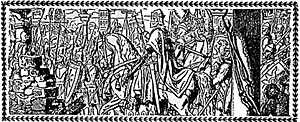
At HISTORICON this past July, Brian Lewis put on a very interesting and FUN multi-player game of Armati involving Slavs, Vikings, Pechenegs, Russ, and Varangians, among others. Each of the five commanders per side were given an 'army' of several units and faced a comparable force of enemy troops. An overall C-in-C for each side oversaw the conglomerate forces and issued initial orders for each of us.
 The following are Brian's modifications of the basic Armati system...actually, to me at any rate, they made the rules much more interesting. Because of the great time we all had and the fact that I believe many of you would like to experiment a bit, here they are.
The following are Brian's modifications of the basic Armati system...actually, to me at any rate, they made the rules much more interesting. Because of the great time we all had and the fact that I believe many of you would like to experiment a bit, here they are.
- The Division concept is scrapped entirely. Units may manoeuvre individually. Replace by two rules:
- Generals have a command radius of 12" (in 15mm). Any unit outside of 12" at the start of their movement phase must die (1-3 on a d6) to be able to move. Also applies to ALL if general is dead.
- Units in hand-to-hand combat receive a -1 modifier to their fighting value if there is not another unit of their command within 3 inches.
- Certain units have a higher fighting value on first contact with any enemy unit. Such units (like Viking Huscarls) have their frontal FV denoted as "x/y", where "x" is the FV on first contact and "y" is the FV in all subsequent rounds of combat vrs. the same unit.
- Certain units, usually Nobles, count as 1 1/2 or 2 Break Points when eliminated. These are denoted by a 1/2 after the Break Point symbol or a second Break Point symbol.
- Certain units with combined close combat and ranged weapons (i.e. Spears/Bows) issue missile fire with a -1 modifier.
- Skirmish infantry can take two hits before being eliminated.
- Because this is a game with multiple commands, the normal initiative procedure is dlspensed with. Alternatively, cards are used, one per command in the game, shuffled and drawn one at a time to determine the order of movement. All movement by one command must be completed before the next card is drawn. Combat direction will move from one end of the table to the other, determined by the C-in-Cs' rolling for it.
- A command is removed after the melee phase if it has reached or exceeded its Break Point.
- Light Woods (a new terrain type) are the same as Woods in the rules, except units fight with their normal FV (minus 1 for Heavy Infantry, -3 for all mounted).
- Heavy Infantry does not disperse Light Infantry. Skirmish Infantry is still dispersed by Heavy Infantry in the same circumstances as listed in the rules.
I would also like to add that with this type of scenario that Brian has developed, different troop types and allies can be used. In fact, the DBM/WRG army lists can be utilized as well, keeping in mind that the rigid units (number of figures per type) must be adhered to in the Armati rules booklet.
This was a lot of fun with the good guys (my side) ultimately winning the contest in a little over two hours. Not bad for a game with tons of lead in use. If any of you have any 'home rule adaptations' such as this, please send them in so that I can pass them along to our other readers. I know I enjoy reading them and am always on the lookout for a new idea or concept.
Back to Saga #55 Table of Contents
© Copyright 1996 by Terry Gore
This article appears in MagWeb (Magazine Web) on the Internet World Wide Web.
Other military history articles and gaming articles are available at http://www.magweb.com